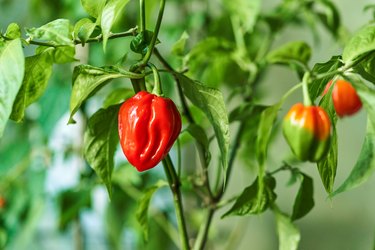
Lots of gardeners grow sweet peppers (Capsicum annuum), which are reliable producers and a versatile kitchen vegetable. For those who are more adventurous in the kitchen, hotter peppers like the habanero (Capsicum chinense, USDA zones 10-12) can be an interesting change of pace. They're grown very similarly and have an equally long harvest period, with early (green) harvesting starting around 75 days after transplant and fully ripened fruit available at up to 110 days from transplant.
Tip
Like other peppers, habaneros can be picked when green or fully ripened. Harvest falls at roughly 75 to 110 days after transplant, depending on which way you prefer them.
Video of the Day
Growing Conditions for Habanero Peppers
Habaneros and other peppers are part of the nightshade family (Solanaceae), like tomatoes, potatoes and eggplants. Potatoes are the only one of those that prefers cool conditions; the others favor warm or even semitropical climates. Peppers need a longer period of warm weather than tomatoes do and, in fact, prefer warmer conditions.
Video of the Day
Peppers won't germinate at all, or they'll germinate poorly, at soil temperatures below 55 degrees Fahrenheit. The plants won't flourish if the overnight lows go below 60 F and soil temperatures stay below 65 F, and they won't tolerate frost at all without protection. For most gardeners, this makes direct-seeding a long shot. Mature habaneros can take up to 110 days from transplant and must be started eight to 10 weeks before transplant, so direct seeding requires up to 180 days of suitably balmy weather.
Unless you know for certain that gardeners in your area routinely grow habaneros or other peppers from direct-seeding them in the garden, assume that you'll need to start yours indoors from seed or from transplants.
When to Start Habanero Seedlings
Habaneros typically produce a lot of fruit, and they're hot enough that a little goes a long way, so you'll likely need only a few plants — four to eight — to provide as many peppers as you'll use in a year. The easy option is to buy healthy, vigorous transplants from a nursery right around planting time, so all you need to do is acclimate them to conditions in your garden before planting.
You'll typically need to wait two to three weeks past your last frost date before transplanting, because your soil and overnight temperatures won't be high enough until then. If you opt to start your own, count backward about eight weeks from that point — not from the frost date itself — for sowing your seeds. This gives you leeway to wait until the soil and air temperatures are mild enough and provides time to harden off your seedlings. You'll need to move them to larger pots as they grow to prevent them from becoming root-bound.
Transplanting Habanero Seedlings
Whether you opt to buy your transplants or start them at home from seeds, "hardening off" — slowly acclimating your seedlings to outdoor conditions — is an important, but often-rushed, step in the process. It simply means setting your seedlings out in the sun and outside air for increasing periods of time, over the span of a couple of weeks. They should be 4 to 6 inches tall at this point and sturdy-looking rather than spindly.
Start as soon as your afternoon temperatures get up into the mid-60s F, bringing the tender seedlings in again as the temperature begins to fall (an indoor-outdoor thermometer that records minimum and maximum temperatures can be very useful at this point in the gardener's year). As the days grow warmer and the plants grow more accustomed to the sunshine and outdoor breezes, you can lengthen their outdoor time until they're spending all day outside. At this point, you can transplant them into their bed.
Soak each seedling's root ball by immersing it in water, then plant them 18 to 24 inches apart. Keep them at the same depth they knew in their starter pots; if you bury them more deeply, the stems can rot.
Growth and Harvest of Habaneros
Be diligent about weeding until your habaneros are well-established. It's best to weed by hand or use a plastic mulch rather than using a cultivator or weeding tool; pepper roots are fairly shallow and can be damaged by a hoe or claw-type cultivator. They'll also benefit from additional feeding, especially at blossom and fruit set. Nitrogen encourages leaf growth but leads to lower yields, so use a 1-2-1 or 1-2-2 fertilizer.
Keep the soil evenly moist throughout blossoming and fruit set to encourage heavy bearing. You can begin harvesting green habaneros as soon as they're large enough (an inch or more in diameter), or leave them on the plant to ripen to their mature hues of red, orange and yellow. Mature peppers will have a rich, fruity, apricot-like note to their aroma and flavor.
If you want extra-hot peppers, you can encourage them to concentrate capsaicin by withholding water as the peppers reach maturity. Whether you deliberately grow them extra-hot or just harvest them as-is, bear in mind that habaneros contain a lot of capsaicin. Wear gloves whenever you handle them — including at harvest! — because getting capsaicin on your fingers and then transferring it accidentally to your eyes or mucous membranes is a memorably painful experience.